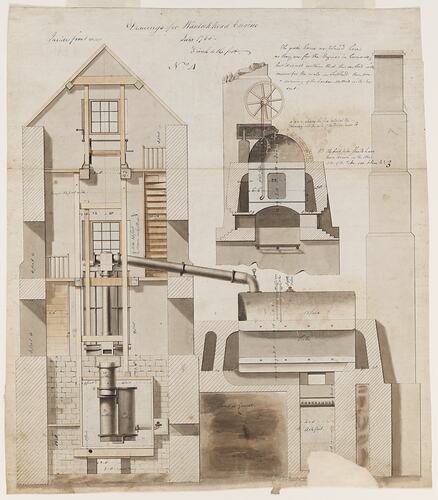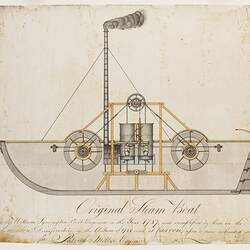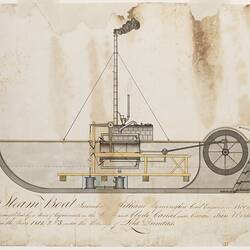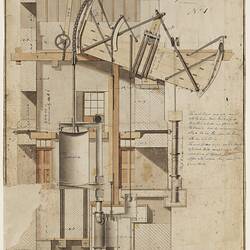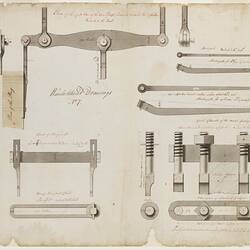Summary
Hand-coloured ink and watercolour drawing showing a general arrangement and cross-sections for an atmospheric condensing beam pumping engine and associated steam boiler designed by James Watt and supplied by the firm Bolton & Watt, of Birmingham, to the Margaret Mine, at Wanlockhead, Scotland, in 1785-86. Scale: 1/3 inch to 1 foot. The drawing is part of a set of technical drawings supplied by the manufacturers showing general arrangements, details of foundations and key components for a 55-inch (1397 mm) bore x 8 foot (2438 mm) stroke single-acting single-cylinder steam pumping engine ordered by Gilbert Meason, general manager of the Wanlockhead Mining Company for the Margaret Mine in June 1785. Labelled as sheet No.4, it shows (at left) a transverse cross-sectional elevation through the three-storey engine house with inside front view of the access stairways, steam cylinder, condenser and air pump in position within the building, and (at right) transverse and longitudinal cross-sections through a 'hay stack' style steam boiler in its masonry setting, including details of the internal flues, fire grate, ash pit, air damper, water gauge glasses, safety valve, chimney and steam pipe connecting the boiler to the steam chest on the engine. The drawing is believed to have been executed by James Watt, or an assistant working under his direction, and includes a number of annotations written in blue ink in what appears to be Watt's hand, giving selected dimensions of the general assembly and other notes to the erectors.
The engine depicted was built to replace a smaller 36-inch (914 mm) bore Boulton & Watt pumping engine erected in 1778-79, which was found to be too underpowered to cope with the drainage load as the mine workings went deeper. At the time that both Watt engines were built for the Wanlockhead mines, Boulton & Watt had not yet established their Soho Foundry (1795), and it was their general practise to just supply drawings for the erection of their engines and organise for the supply of key components from a number of third-party engineering firms across northern England and the midlands. Generally a skilled erector would be sent by Boulton & Watt to supervise installation and commissioning of each engine, but in the case of the Wanlockhead engines, none of Boulton & Watt's regular experts were available, so the work was left in the hands of the mining company's engineer George Symington, assisted by his younger brother, William Symington. The experience would provide one of the most important formative events in the subsequent career of twenty-one year old William, and would help set him on the course of a life-long interest in the applications and improvements of steam technology.
Wanlockhead is a historic mining village situated in the Lowther Hills region of the Scottish Southern Uplands, at the head of the Mennock Pass. It is noted for being Scotland's highest village at an average elevation of 1,531 feet (467 m) above sea level. The area has been exploited since at least Roman times for its mineral resources, which include deposits of lead, zinc, copper, silver and gold. The current village was founded in 1680 when Sir James Stampfield built a lead smelting plant and workers' cottages. Beam pumps powered by a self-acting water bucket were introduced to drain the Wanlockhead mines in 1745. The Wanlockhead Mining Company was formed by Ronald Crawford and associates in 1755, and energetically exploited the area's rich lead veins over the following sixty years, working deposits to depths of over 540 feet (165 m), and producing 47,420 tons of lead. They were the first Scottish mine owners outside the Edinburgh coalfields to adopt seam powered pumping technology.
William Symington appears to have kept several of the original Wanlockhead Steam Engine drawings as a memento of his involvement and would later pass them onto his second-oldest son, William Symington junior (c.1802-1867), who bought the surviving drawings to Australia when he emigrated in 1855. They were subsequently donated to Museum Victoria by a descendant of the family.
Description of Content
WANLOCKHEAD ENGINE DRAWING NO. 4 BY JAMES WATT. JUNE 1875. FURTHER DOCUMENTATION REQUIRED. TO BE NUMBERED.
Physical Description
Scaled (1/3 inch to 1 foot), coloured (brown, grey, black) technical line drawing annotated with handwritten text and dimensional details in blue ink. The drawing shows a sectional view of the engine house (at left) showing key parts of the steam engine and condenser with cutaway building details and foundations. A 'hay stack' style boiler with associated masonry foundations and setting and a tiered masonry chimney is shown (at right) alongside the engine house as a longitudinal section (including fire grate and ash pit), with a steam pipe connecting the boiler to the engine. A transverse section of the boiler and masonry setting is also shown (above right) with details of the air damper behind.
More Information
-
Collecting Areas
-
Acquisition Information
Cultural Gifts Donation from Dr Graeme R. Symington, by 03 Feb 1993
-
Creator (Attributed)
Mr James Watt, Birmingham, Staffordshire, England, Great Britain, 1785
-
Manufacturer of Item Depicted
Boulton & Watt, Birmingham, Staffordshire, England, Great Britain, circa 1785-1787
-
Place Named
-
Past Owner or User
Mr William Symington Snr, C.E., Scotland, Great Britain, circa 1785-1831
-
Past Owner
Mr William Symington Jnr, C.E., Bacchus Marsh, Victoria, Australia, circa 1855-1867
-
Past Owner
Miss Nancy M. Symington, Bacchus Marsh, Victoria, Australia
Great-granddaughter of William Symington, snr. She owned the drawings prior to passing them on to the donor. -
Individuals Identified
WATT, JAMES
-
Format
Drawing
-
Inscriptions
Title, top, handwritten: 'Drawings for Wanlockhead Engine / June 1785 / 1/3 inch to the foot / No. 4' Watermark: 'J Whatman' [embellished 'fleur de lis'] Top left, handwritten: 'Inside front view' Notes, top right, handwritten: 'The grate barrs are placed here / as they are for the Engines in Cornwall, / but it is not certain that this method will answer for the coals in Scotland, therefore a drawing of the London Method will be / sent.', 'aaaa, ahows the flue betwixt the / chimney and the end of the boiler next it.', 'NB. The feed pipe should have / been drawn on the other / side of the tube see plan no. 3' Other handwritten annotations: 'Guage [sic] cocks', 'Safety valve', 'tube', 'ashpit', 'Sand or Gravel', 'house 14 feet wide'
-
Brand Names
-
Classification
Mechanical engineering, Steam power, Diagrams - beam steam engines
-
Category
-
Discipline
-
Type of item
-
Overall Dimensions
395 mm (Width), 457 mm (Height)
-
References
[Book] Harvey, W.S. & Downs-Rose, G. 1980. William Symington - Inventor and Engine Builder., See plate 6, p.16. Pages
-
Keywords
Atmospheric (Steam) Engines, Beam Engines, Engineers, Engines, Innovation & Design, Inventions, Lead Mining, Mining Equipment, Pumping Engines, Steam Boilers, Steam Engines
